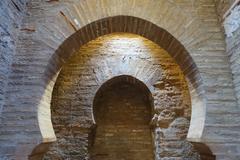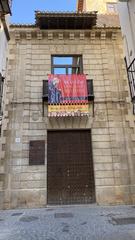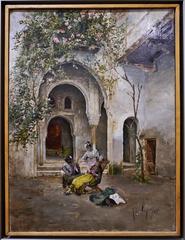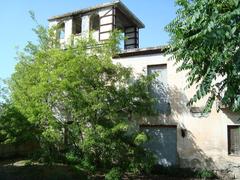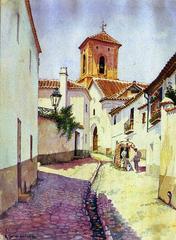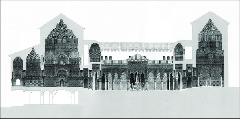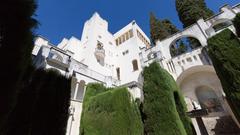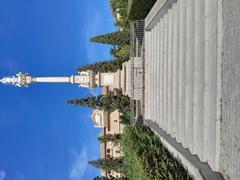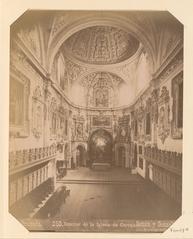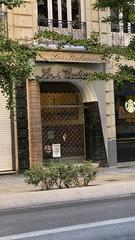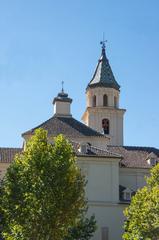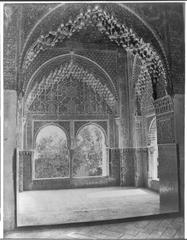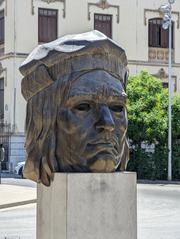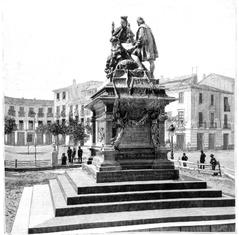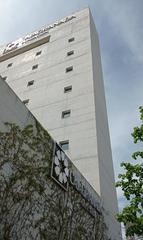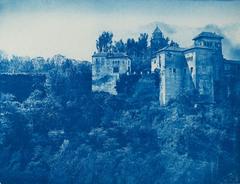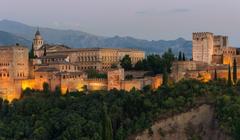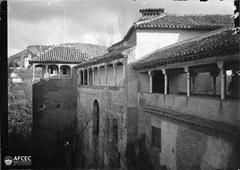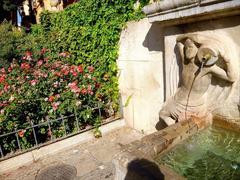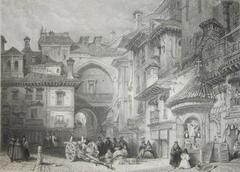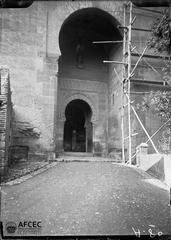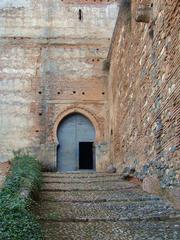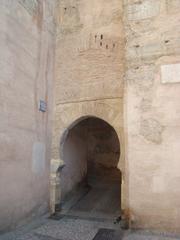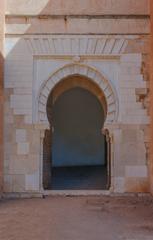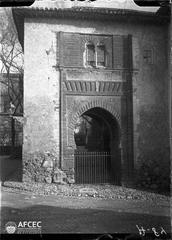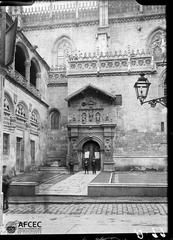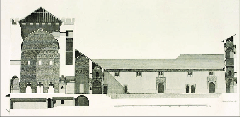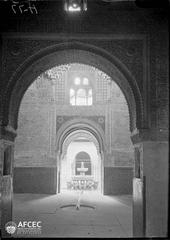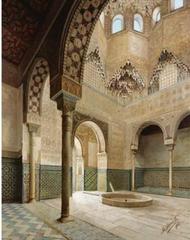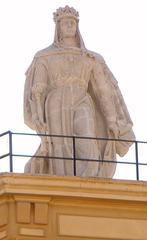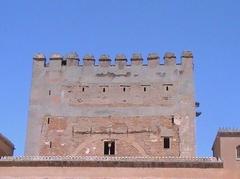Oratorio del Mexuar Visiting Hours, Tickets, and Granada Historical Sites Guide
Date: 14/06/2025
Introduction
Nestled within the iconic Alhambra complex in Granada, Spain, the Oratorio del Mexuar is an architectural and spiritual treasure that offers visitors a window into the rich cultural, religious, and political history of medieval Andalusia. This intimate prayer room, built during the Nasrid dynasty (13th–15th centuries), functioned as the Sultan’s private devotional space and was intertwined with the political heart of the Mexuar palace. With its exquisite Nasrid craftsmanship—including intricate stucco, geometric tile mosaics, and a beautifully adorned mihrab—the oratory harmonizes Islamic artistry with later Christian modifications, reflecting Granada’s history of conquest and coexistence.
This comprehensive guide details the Oratorio’s historical significance, architectural highlights, visiting information (including ticketing, hours, and accessibility), travel tips, and nearby attractions, ensuring you can plan a rewarding visit to this remarkable site. Whether you are a history enthusiast, art lover, or a casual traveler, the Oratorio del Mexuar is a must-see for anyone seeking to explore Granada’s extraordinary heritage. (madainproject.com; guiasgranada.com; alhambra-patronato.es)
Table of Contents
- Introduction
- Historical Background
- Architectural Features
- Visiting the Oratorio del Mexuar
- Restoration and Conservation
- Nearby Attractions
- Frequently Asked Questions (FAQ)
- Summary and Recommendations
- Sources and Further Reading
Historical Background
Origins and the Nasrid Era
The Oratorio del Mexuar is part of the larger Mexuar complex, the administrative and judicial heart of the Nasrid palaces within the Alhambra. Its name derives from the Arabic “Maswar,” meaning a place for consultation, underscoring its political role as the Sultan’s council hall and audience chamber. The oratory itself was designed as a private prayer room for the Sultan, featuring a mihrab oriented towards Mecca and panoramic views of Granada. Its position at the northeastern edge of the Mexuar courtyard highlights its dual spiritual and administrative function. (madainproject.com; es.wikipedia.org)
Religious and Cultural Significance
The Oratorio del Mexuar served as a dedicated space for Islamic prayer and reflection, accessible via the Machuca Gallery. Its design—with windows inviting contemplation and inscriptions such as “Come to prayer. Do not be among the negligent”—emphasizes its role in fostering daily spiritual practices. The oratory also embodied the Nasrid ideal of unified spiritual and temporal authority, serving as the Sultan’s antechamber for both devotion and the dispensation of justice. The intricate tilework, stucco, and Arabic calligraphy reflect the artistic zenith of Nasrid Granada, while later Christian modifications (post-1492) further layered its cultural significance. (guiasgranada.com)
Architectural Features
Layout and Spatial Organization
The Oratorio del Mexuar is annexed to the north end of the Sala del Mexuar, forming part of the oldest Nasrid palace structures in the Alhambra. Originally accessed via the Patio de Machuca, the oratory is a rectangular chamber designed for privacy and contemplation. Its orientation aligns precisely toward Mecca, in accordance with Islamic tradition. The ground level was lowered in modern times to facilitate visitor access, but originally it was higher and aligned with the stone bench beneath the windows. (official Alhambra website; nomads-travel-guide.com)
Decorative Elements
- Structural Details: Four central marble columns with polychrome capitals support the Sala del Mexuar, remnants of the original lantern-like structure. The oratory itself lacks columns but features robust walls, arched windows, and the prominent mihrab.
- Windows and Light: Four front balconies, each with twin arches, allow natural light to fill the space and offer breathtaking views of the Albaicín district, linking the sacred interior with Granada’s landscape. (alhambra.info)
- Mihrab: The mihrab, set into the qibla wall, features a horseshoe arch and polylobed plan, richly adorned with stucco and Quranic inscriptions that exhort worship and reinforce the sanctity of the space. (nomads-travel-guide.com)
- Tilework and Inscriptions: Lower walls feature intricate Nasrid tilework (alicatados), while epigraphic stucco above bears religious and dynastic phrases such as “The kingdom, the greatness, and the glory are God’s.” Some original polychromy survives, revealed through modern restoration efforts.
Christian Modifications
After the Christian conquest of Granada in 1492, the Oratorio and adjacent rooms were converted into a chapel. Additions included a wooden choir balcony and an altar flanked by Hercules columns. Despite these changes, many original Islamic features and decorations remain, creating a unique blend of styles. (visitasguiadasalhambra.online)
Visiting the Oratorio del Mexuar
Visiting Hours and Tickets
- Opening Hours: The Alhambra complex, including the Nasrid Palaces and the Mexuar, is generally open from 8:30 a.m. to 8:00 p.m. (April–October) and 8:30 a.m. to 6:00 p.m. (November–March). Timed entry is strictly enforced for the Nasrid Palaces; check the official website for updates.
- Tickets: Admission requires an advance-purchased ticket, which includes access to the Nasrid Palaces. Prices are typically €14–€16 for adults, with discounts for EU citizens under 25 and free entry for children under 12. Book tickets well in advance, especially for peak seasons.
Accessibility
Efforts have been made to improve accessibility throughout the Alhambra. However, the Oratorio del Mexuar has stairs and narrow passages, making access challenging for visitors with reduced mobility. Contact visitor services for detailed accessibility information.
Guided Tours and Travel Tips
- Guided Tours: Expert-led tours and audio guides are highly recommended for deeper insight into the Oratory’s history and symbolism.
- Best Times: Early morning or late afternoon visits are ideal for avoiding crowds and enjoying better light for photography.
- Photography: Photography without flash or tripods is allowed. Always respect signage and other visitors.
- Facilities: Restrooms, cafés, and gift shops are located near the main entrances, but not within the Nasrid Palaces.
- Time Management: Allocate at least 2–3 hours for the Nasrid Palaces, including the Oratorio; the entire Alhambra may take 4–6 hours.
Restoration and Conservation
The Oratorio del Mexuar suffered significant damage in a 1590 explosion and underwent major restorations in the 19th and 20th centuries, notably by architect Leopoldo Torres Balbás. Ongoing conservation efforts use modern technology to preserve its delicate ornamentation and original polychromy. (visitasguiadasalhambra.online)
Nearby Attractions
- Within the Alhambra:
- Palace of the Lions
- Generalife Gardens
- Alcazaba Fortress
- Outside the Alhambra:
- Albaicín district (UNESCO World Heritage Site)
- Mirador de San Nicolás (panoramic views)
- Granada Cathedral
Frequently Asked Questions (FAQ)
Q: What are the Oratorio del Mexuar visiting hours?
A: The Alhambra is generally open from 8:30 a.m. to 8:00 p.m. (April–October) and until 6:00 p.m. (November–March). Check the official website for current schedules.
Q: How do I buy tickets?
A: Tickets must be purchased in advance online via the official Alhambra website or authorized vendors.
Q: Is the Oratorio del Mexuar wheelchair accessible?
A: Accessibility is limited due to historic features. Contact visitor services for the most up-to-date information.
Q: Can I enter the Oratory?
A: Visitors can view the Oratory only from the doorway to protect its fragile decoration.
Q: Are guided tours available?
A: Yes, many guided tours and audio guides cover the Oratorio del Mexuar and the Nasrid Palaces.
Q: Is photography allowed?
A: Photography without flash or tripods is generally permitted; follow posted guidelines.
Summary and Recommendations
The Oratorio del Mexuar is an exceptional testament to Granada’s rich Islamic and multicultural heritage. Its exquisite architecture and decoration, layered with centuries of history, make it a highlight of any visit to the Alhambra. While entry is restricted to preserve its delicate features, visitors can still appreciate its beauty from designated viewpoints and through guided tours. For a seamless experience, book tickets well in advance, respect timed entry slots, and consider visiting during quieter hours. Exploring nearby attractions will broaden your understanding of Granada’s historical and cultural landscape.
For the latest information on visiting hours, tickets, and accessibility, consult the official Alhambra website and consider using resources like the Audiala app for audio tours and travel tips.
Sources and Further Reading
- Visiting the Oratorio del Mexuar: History, Tickets, and Travel Tips (madainproject.com)
- Oratorio del Mexuar in Granada: History, Visiting Hours, Tickets & Travel Tips (guiasgranada.com)
- Oratorio del Mexuar Visiting Hours, Tickets, and Historical Highlights in Granada (alhambra-patronato.es)
- Oratorio Del Mexuar Visiting Hours, Tickets, and Visitor Guide in Granada’s Alhambra (alhambra-patronato.es)
Image suggestions:
- Exterior view of the Oratorio del Mexuar with balconies (alt: “Oratorio del Mexuar balconies overlooking Albaicín in Granada”)
- Interior view of the mihrab (alt: “Mihrab of Oratorio del Mexuar decorated with stucco and inscriptions”)
- Map of the Alhambra highlighting the Oratorio del Mexuar location
Related articles:
- Guide to the Nasrid Palaces of the Alhambra
- Visiting the Alhambra: Tickets and Tips
- Exploring the Albaicín Neighborhood

